1993 BUICK REGAL turn signal
[x] Cancel search: turn signalPage 14 of 308

Vehicle Symbols
These are some of the symbols you will find on your vehicle.
For example,
these symbols
are used on an
original battery:
POSSIBLE A
CAUTION
INJURY
PROTECT EYES BY
SHIELDING
CAUSTIC
BURNS AVOID
SPARKS
OR
FLAMES
SPARK
OR ,\I/,
COULD FLAME
EXPLODE BATTERY
These symbols
are important
for you and
your passengers
whenever your
vehicle
is
driven:
DOOR LOCK
UNLOCK
e
e
BELTS 4
POWER
WINDOW
These symbols
have
to do with
your lights:
SIGNALS e @
TURN
HIGH BEAM
OR = =o
FOG LAMPS $0
These symbols
are on some
of
your controls:
WINDSHIELD ' ' ' 0- 0-
WASHER
WINDSHIELD WASHER
WINDOW
DEFOGGER
VENTILATING FAN
HEADLAMP
-
WIPER
WASHER
Q
These symbols
are
used on
warning and
indicator lights:
COOLANT F-
TEMP --
ENGINE
CHARGING
I-1
BATTERY SYSTEM
BRAKE
(0)
RADIATOR 0
COOLANT
FUEL
ENGINE OIL w,
PRESSURE
TEMP
OIL &b
ANTILOCK (a)
BRAKE
Here are some
other symbols
you may see:
FUSE
RADIO
VOLUME
CONDITIONING
AIR 43
HATCHBACK TRUNK
RELEASE
t LIGHTER
HORN
SPEAKER
12
ProCarManuals.com
Page 59 of 308
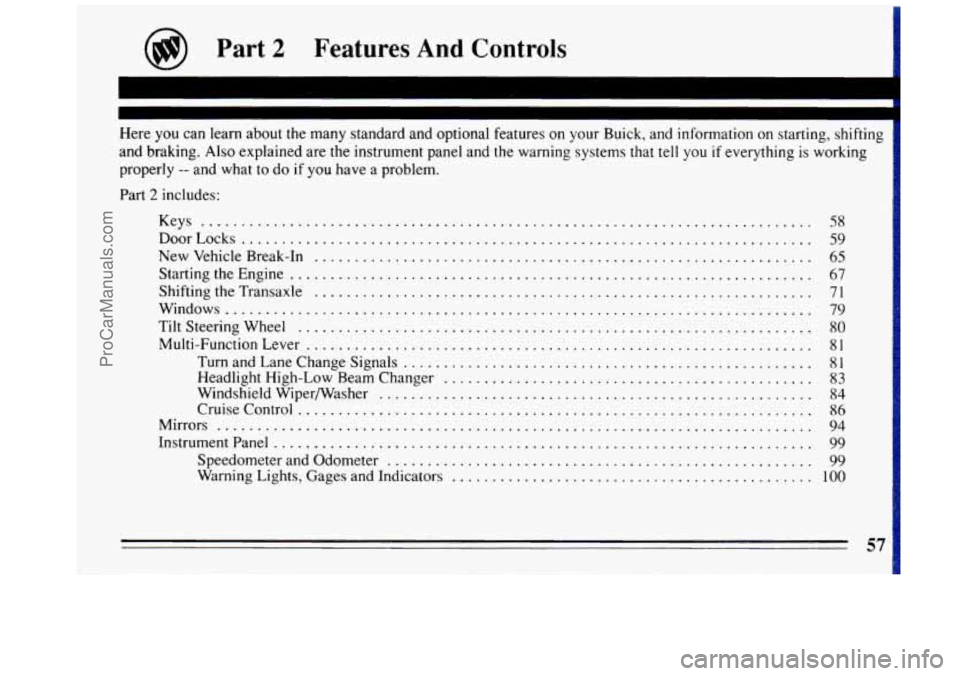
'art 2 Features And Controls
Here you can learn about the many standard and optional features on your Buick. and information on .. starting. shifting ..
and braking . Also explained are the instrument panel and
properly
.. and what to do if you have a problem .
Part 2 includes: the warning
systems that tell you
if every
Thing is working
Keys ........................................................................\
....
DoorLocks ....................................................................... \
NewVehicleBreak-In ..............................................................
StartingtheEngine .................................................................
ShiftingtheTransaxle ..............................................................
Windows ........................................................................\
.
TiltSteeringWheel ................................................................
Multi-FunctionLever ...............................................................
TurnandI, aneChangeSignals ...................................................
Headlight High-Low Beam Changer ..............................................
WindshieldWiper/Washer ......................................................
Cruisecontrol ................................................................
Mirrors ........................................................................\
..
Instrumentpanel ...................................................................
Speedometer and Odometer .....................................................
Warning Lights, Gages and Indicators .............................................
58
59
65
67
71
79
80
81
81
83
84
86
94
99
99
100
ProCarManuals.com
Page 83 of 308

To tilt the wheel, hold the steering wheel and pull the
lever. Move the steering wheel to a comfortable level,
then release the lever to lock the wheel in place.
The Turn Signal/Headlight Beam
Lever
TE
If
The lever on the left side of the steering column
includes your:
0 Turn Signal and Lane Change Indicator
0 Headlight High-Low Beam & Passing Signal
0
0
0
0
Flash-To-Pass Feature
Windshield Wipers
Windshield Washer
Cruise Control (Option)
Turn Signal and Lane Change
Indicator
The turn signal has two upward (for Right) and two
downward (for Left) positions. These positions allow
you to signal a turn or a lane change.
81
ProCarManuals.com
Page 84 of 308

To signal a turn, move the lever all the way up or down.
When the turn
is finished, the lever will return
automatically.
A green arrow on the
instrument panel will flash in the direction of the turn
or lane change.
To signal a lane change, just raise or lower the lever
until the green arrow starts to flash. Hold it there
until
you complete your lane change. The lever will return by
itself when
you release it.
As you signal a turn or a lane change, if the arrows don’t
flash but just stay
on, a signal bulb may be burned out
and other drivers won’t see your
turn signal. If
a bulb
is burned out, replace it to help avoid an
accident. If the green arrows don’t
go on at all when you
signal a turn, check the fuse (see “Fuses” in the Index)
and for burned-out bulbs.
Turn Signal “ON” Chime
A chime will sound if your turn signal is left on after
having gone
3/4 mile, to remind you to turn your signal
off.
Operation of Lights
Although your vehicle’s lighting system (headlights,
parking lights, fog lamps, side marker lights and
taillights) meet
all applicable federal lighting
requirements, certain states and provinces may apply
their own lighting regulations that may require special
attention before you operate these lights. For example,
some jurisdictions may require that you operate your
lower beam lights with fog lamps at all times, or that
headlights be turned on whenever you must use your
windshield wipers. In addition,
most jurisdictions
prohibit driving solely with parking lights, especially at
dawn or dusk. It is recommended that you check with
you own state or provincial highway authority for
applicable lighting regulations.
82
-
ProCarManuals.com
Page 85 of 308
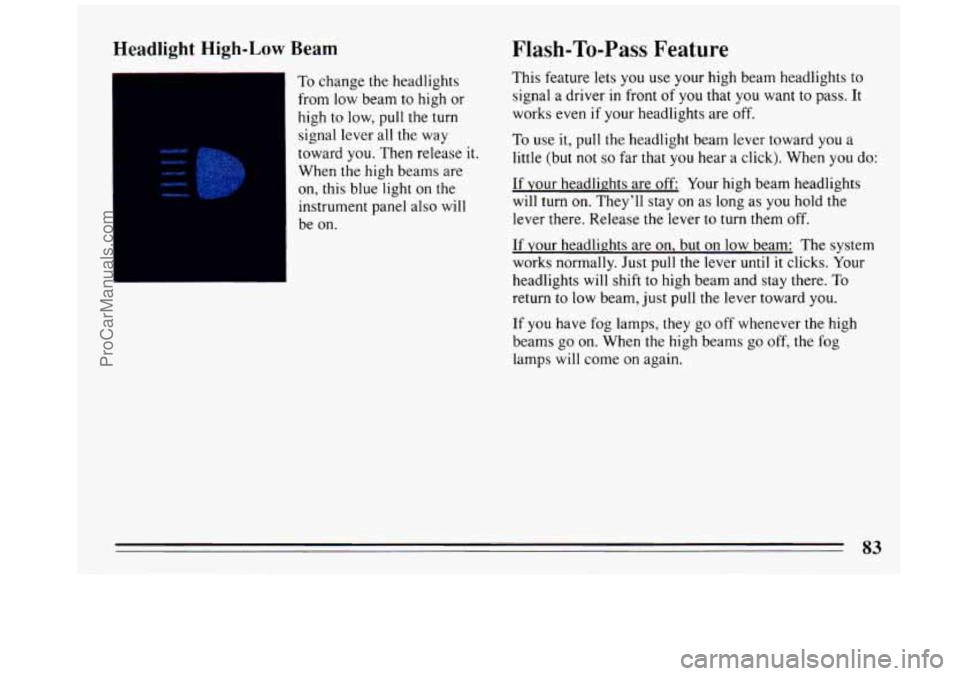
Headlight High-Low Beam
rc
To change the headlights
from low beam to high or
high to low, pull the turn
signal lever all the way
toward you. Then release
it.
When the high beams are
on, this blue light on the
instrument panel also will
be on.
Flash-To-Pass Feature
This feature lets you use your high beam headlights to
signal a driver
in front of you that you want to pass. It
works even if your headlights are off.
To use it, pull the headlight beam lever toward you a
little (but
not so far that you hear a click). When you do:
If your headlights are off Your high beam headlights
will
turn on. They’ll stay on as long as you hold the
lever there. Release the lever
t.o turn them off.
If your headliphts are on, but on low beam: The system
works normally. Just pull the lever until
it clicks. Your
headlights will shift to high beam and stay there.
To
return to low beam, just pull the lever toward you.
If
you have fog lamps, they go off whenever the high
beams go on. When the high beams
go off, the fog
lamps will come
on again.
83
ProCarManuals.com
Page 102 of 308
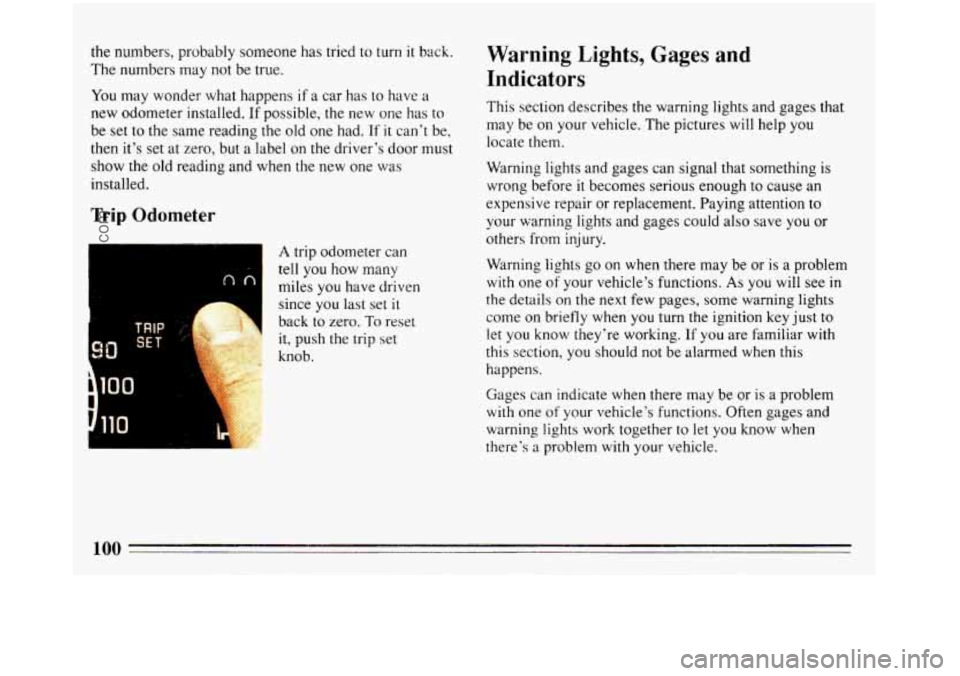
the numbers, probably someone has tried to turn it back.
The numbers may not be true.
You may wonder what happens if a car has to have a
new odometer installed. If possible, the new one has to
be set to the same reading the old one had. If it can’t be,
then it’s set at zero, but
a label on the driver’s door must
show the old reading and when the new one was
installed.
Trip Odometer
TRIP
SET 90
A trip odometer can
tell
you how many
miles you have driven
since you last set
it
back to zero. To reset
it, push the trip set
knob.
Warning Lights, Gages and
Indicators
This section describes the warning lights and gages that
may be on your vehicle. The pictures will help you
locate them.
Wdrning lights and gages can signal that something
is
wrong before it becomes serious enough to cause an
expensive re,pair or replacement. Paying attention to
your warning lights and gages could also save you or
others from injury.
Warning lights go on when there may be or
is a problem
with one of your vehicle’s functions. As you will see in
the details on the next few pages, some warning lights
come on briefly when you turn
the ignition key just to
let you know they’re working.
If you are familiar with
this section, you should not be alarmed when this
happens.
Gages
can indicate when there may be or is a problem
with one of your vehicle’s functions. Often gages and
warning lights work together
to let you know when
there’s a problem with your vehicle.
100
ProCarManuals.com
Page 126 of 308
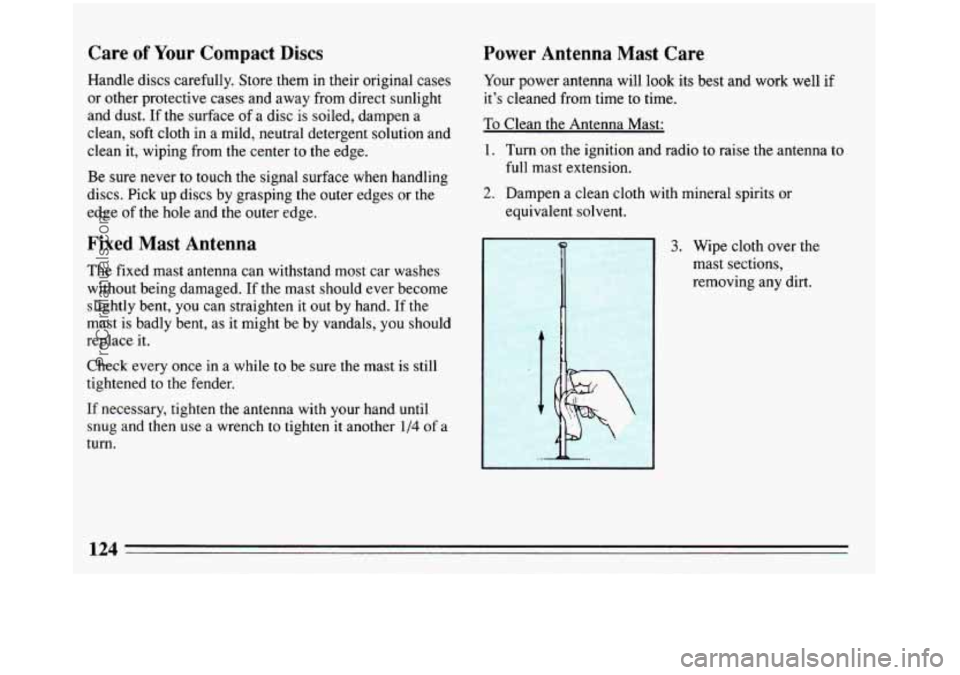
Care of Your Compact Discs
Handle discs carefully. Store them in their original cases
or other protective cases and away from direct sunlight
and dust. If the surface of a disc is soiled, dampen a
clean, soft cloth in a mild, neutral detergent solution and
clean it, wiping from the center to the edge.
Be sure never to touch the signal surface when handling
discs. Pick up discs by grasping the outer edges or the
edge
of the hole and the outer edge.
Fixed Mast Antenna
The fixed mast antenna can withstand most car washes
without being damaged. If the mast should ever become
slightly bent, you can straighten it
out by hand. If the
mast is badly bent, as it might be by vandals,
you should
replace it.
Power Antenna Mast Care
Your power antenna will look its best and work well if
it’s cleaned from time to time.
To Clean the Antenna Mast:
1. Turn on the ignition and radio to raise the antenna to
full mast extension.
2. Dampen a clean cloth with mineral spirits or
equivalent solvent.
3. Wipe cloth over the
mast sections,
removing any dirt.
Check every once in a while
to be sure the mast is still
tightened to the fender,
If necessary, tighten the antenna with your hand until
snug and then use a wrench to tighten it another
1/4 of a
turn.
124
ProCarManuals.com
Page 136 of 308
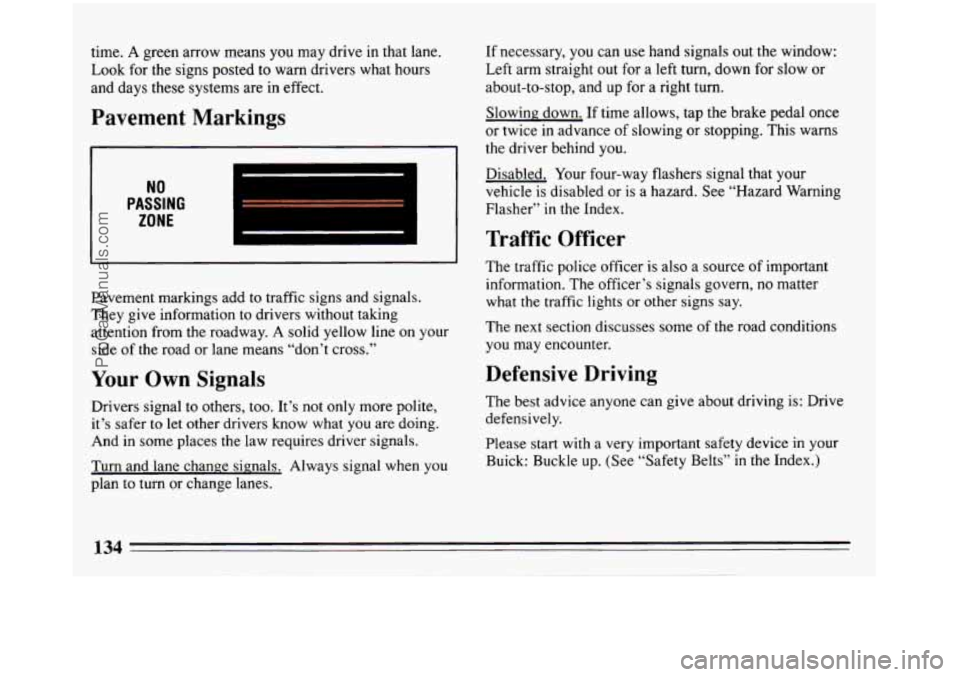
time. A green arrow means you may drive in that lane.
Look for the signs posted to warn drivers what hours
and days these systems are in
effect.
Pavement Markings
NO
PASSING
ZONE
Pavement markings add to traffic signs and signals.
They give information to drivers without taking
attention from the roadway.
A solid yellow line on your
side of the road or lane means “don’t cross.”
Your Own Signals
Drivers signal to others, too. It’s not only more polite,
it’s safer
to let other drivers know what you are doing.
And in some places the law requires driver signals.
Turn and lane change signals. Always signal when
you
plan to turn or change lanes. If
necessary,
you can use hand signals out the window:
Left arm straight out for a left turn, down for slow or
about-to-stop, and up for
a right turn.
Slowing down. If time allows, tap the brake pedal once
or twice in advance of slowing or stopping. This warns
the driver behind you.
Disabled. Your four-way flashers signal that your
vehicle is disabled or
is a hazard. See “Hazard Warning
Flasher”
in the Index.
Traffic Officer
The traffic police officer is also a source of important
information. The officer’s signals govern,
no matter
what
the traffic lights or other signs say.
The next section discusses some of the road conditions
you may encounter.
Defensive Driving
The best advice anyone can give about driving is: Drive
defensively.
Please start with a very important safety device in your
Buick: Buckle up. (See “Safety Belts” in
the Index.)
134
-
ProCarManuals.com